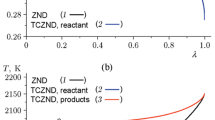Abstract
A new reactive flow model for highly non-ideal explosives and propellants is presented. These compostions, which contain large amounts of metal, upon explosion have reaction kinetics that are characteristic of both fast detonation and slow metal combustion chemistry. A reaction model for these systems was incorporated into the two-dimensional, finite element, Lagrangian hydrodynamic code, DYNA2D. A description of how to determine the model parameters is given.
Similar content being viewed by others
References
E. L. Lee and C. M. Tarver, Phys. Fluids 23, 2362(1980).
J. O. Hallquist, User's Manual for DYNA2D-an Explict Two-Dimensional Hydrodynamic Finite Element Code with Interactive Zoining,” Lawrence Livermore National Laboratory Report UCID-18756, July 1980.
C. M. Tarver and J. O. Hallquist, Seventh Symposium (International) on Detonation, Naval Surface Weapons Center NSWC MP-82-334, Annapolis, MD, 1981, p.488.
C. M. Tarver and L. G. Green, Ninth Symposium (International) on Detonation, Office of the Chief of Naval Research, OCNR 113291-7, Portland, OR, 1989, p.701.
J. W. Kury, H. C. Hornig, E. L. Lee, J. L. McDonnel, D. L. Ornellas, M. Finger, F. M. Strange, and M. L. Wilkins, “Metal Acceleration of Chemical Explosives,” Fourth (International) Symposium on Detonation, ACR-126 (1965).
C. L. Mader, Numerical Modeling of Detonations, University of California Press (1979).
H. M. Sternburg and L. Hudson, “Equations of States for Underwater Explosives”, Proceedings of the 1987 International Symposium on Pyrotechnics and Explosives, Beijing, China, China Academic Press.
M. Cowperthwaite and W. H. Zwisler, Users Guide of the TIGER Computer Program, Stanford Research Institute, Menlo Park, California, (1984).
P. J. Miller and R. H. Guirguis, “Experimental Study and Model Calculations of Metal Combustion in Al/AP Underwater Explosives,” in Structure and Properties of Energetic Materials, Edited by J. Gilman, R. Armstrong D. Liebenberg (Mater. Res. Soc. Proc, MRS publication Vol. 296, page 299, Pittsburgh, PA, 1993.)
P. J. Miller, “A Small-Scale Experiment to Characterize Underwater Explosives,” 1993 JANNAF Propulsion Systems Hazards Subcommittee Meeting, CPIA publication 599, page 55, Fort Lewis, WA.
P. J. Miller and R. H. Guirguis, “Effects of Late Chemical Reactions on the Energy Partition in Non-Ideal Underwater Explosions”, Proceedings of the Joint AIRAPT/APS Conference on High Pressure Science and Technology, June, 1993, Colorado Springs, CO., page 1417, 1993.
R. H. Guirguis and P. J. Miller, “Time-Dependent Equations of State for Aluminized Underwater Explosives,” in The Tenth Symposium (International) on Detonation, ONR, Arlington, VA, OCNR 33395-12, page 665, 1993.
P. J. Miller, “Metal Acceleration by Composite Explosives Containing Aluminum,” Bulletin of American Physical Society, Vol.39, page 926, 1994. Presented at APS Meeting on Condensed Matter in Pittsburgh, PA April 1994.
P. J. Miller, “Reaction Kinetics of Aluminum Particles in Detonation Gases,” JANNAF PSHS Proceedings, San Diego, CA, CPIA publication 615, 1994, page 413.
R. H. Guirguis, “Relation Between Early and Late Energy Release in Non-Ideal Explosives,” Proceedings of the 1994 JANNAF PSHS, San Diego, CA, CPIA publication 615, page 383.
C. Merrill, A. Nichols, and E. Lee, “Explosive Response of HTPB Propellants to Impact and Shock” 1994 JANNAF PSHS Meeting Proceedings, San Diego, CA, CPIA publication 615, 1994 page 343.
W. E. Brown, D. Dollimore, and A. K. Galwey, in Comprehensive Chemical Kinetics, edited by C. H. Bamford C. F. H. Tipper (Elsevier Scientific Publishers), New York, 1980), p.68.
T. B. Grimley, in Chemistry of the Solid State, edited by W. E. Garner (Butterworths Scientific Publications, London, 1955), p.336.
P. J. Miller, Unpublished Results, This Work.
P. J. Miller, “A Simplified Method for Determining Reactive Rate Parameters for Reaction Ignition and Growth In Explosives,” This Symposium of the 1995 Fall MRS Meeting.
Acknowledgments
The Author acknowledges the continued support of Dr. Judah Goldwasser, Program Officer for the ONR 6.2 Undersea Weaponry program. The Author particularly thanks Dr. Raafat Guirguis of the Naval Surface Warfare Center, White Oak Laboratory, for his help in modifing the DYNA2D hydrocode and for his originality of ideas upon which this paper is based.
Author information
Authors and Affiliations
Rights and permissions
About this article
Cite this article
Miller, P.J. A Reactive Flow Model with Coupled Reaction Kinetics for Detonation and Combustion in Non-Ideal Explosives. MRS Online Proceedings Library 418, 413–420 (1995). https://doi.org/10.1557/PROC-418-413
Published:
Issue Date:
DOI: https://doi.org/10.1557/PROC-418-413



